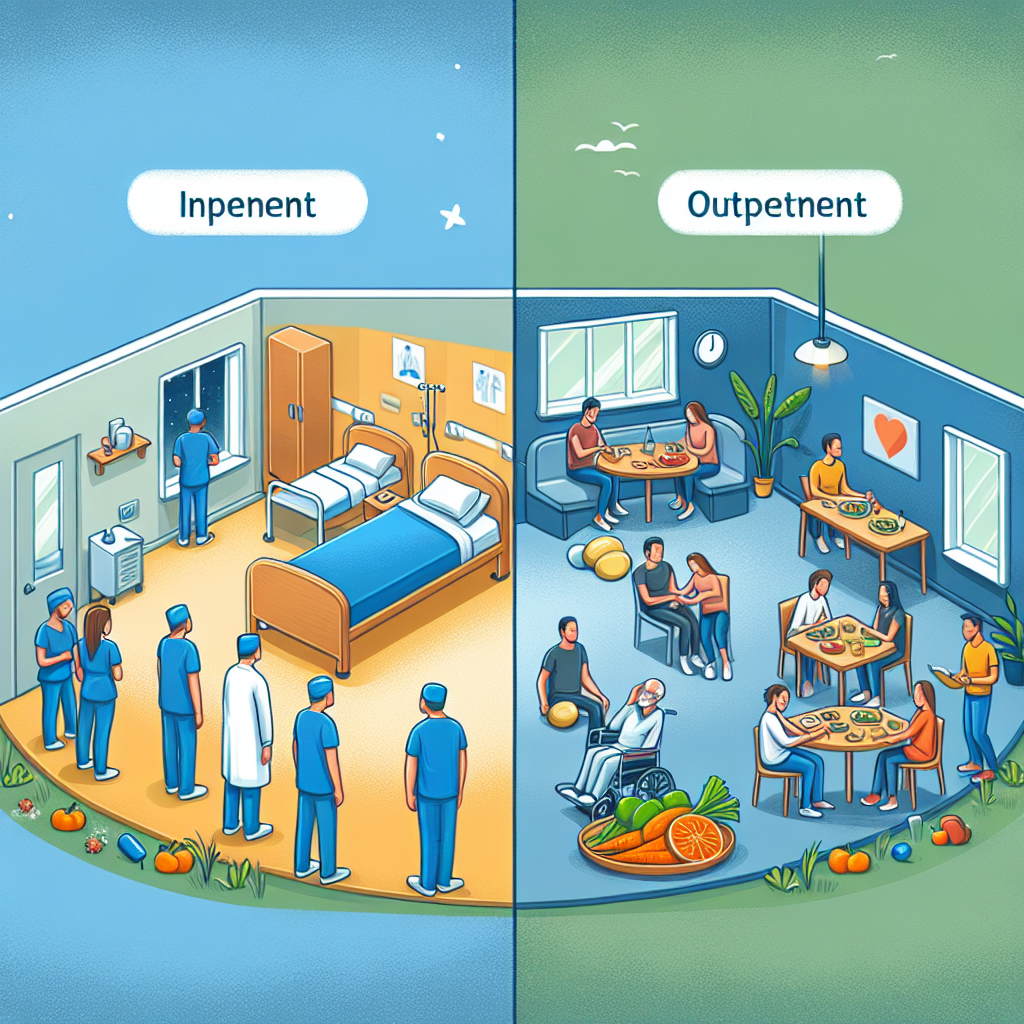-
Table of Contents

“Inpatient Rehab: Immersive, 24/7 Support vs. Outpatient Flexibility and Independence.”
Introduction
Inpatient rehab for drug addiction and outpatient services represent two distinct approaches to addiction treatment, each tailored to meet the varying needs of individuals seeking recovery. Inpatient rehab, also known as residential treatment, involves patients living at a treatment facility for a specified period, typically ranging from 28 days to several months. This immersive environment provides 24/7 medical supervision, structured schedules, and intensive therapeutic interventions, creating a controlled setting that minimizes external triggers and distractions. Conversely, outpatient services allow individuals to live at home while attending scheduled treatment sessions at a clinic or facility. This flexibility enables patients to maintain their daily responsibilities, such as work or family commitments, while receiving support through counseling, group therapy, and other therapeutic activities. The primary differences between these two modalities lie in the level of supervision, intensity of treatment, and the degree of disruption to daily life, making the choice between inpatient and outpatient services a critical decision based on the severity of addiction, personal circumstances, and specific recovery needs.
Key Differences Between Inpatient and Outpatient Drug Rehab Services
In the journey toward overcoming drug addiction, choosing the right type of rehabilitation service is crucial. Inpatient and outpatient rehab services offer distinct approaches, each with its own set of benefits and challenges. Understanding these key differences can help individuals and their loved ones make informed decisions that best support long-term recovery.
Inpatient rehab, often referred to as residential treatment, involves staying at a facility for an extended period, typically ranging from 28 days to several months. This immersive environment provides a structured and supportive setting where individuals can focus entirely on their recovery without the distractions and triggers of everyday life. One of the primary advantages of inpatient rehab is the constant access to medical and therapeutic support. This 24/7 care is particularly beneficial for those with severe addictions or co-occurring mental health disorders, as it ensures immediate assistance in case of a crisis and continuous monitoring of progress.
On the other hand, outpatient rehab allows individuals to live at home while attending treatment sessions at a facility. This flexibility enables them to maintain their daily responsibilities, such as work, school, or family commitments. Outpatient programs vary in intensity, with some requiring daily attendance and others meeting a few times a week. This adaptability makes outpatient rehab an attractive option for those with milder addictions or those who have already completed an inpatient program and are transitioning back to everyday life.
Despite the differences in structure, both inpatient and outpatient rehab share common goals: to help individuals achieve sobriety, develop coping strategies, and build a support network. However, the methods to reach these goals can differ significantly. Inpatient rehab often includes a comprehensive range of therapies, such as individual counseling, group therapy, family therapy, and holistic treatments like yoga and meditation. The immersive nature of inpatient rehab allows for a more intensive therapeutic experience, which can be crucial for addressing deep-seated issues related to addiction.
Conversely, outpatient rehab typically focuses on providing therapy and support in a less intensive format. While it may offer similar types of counseling and group sessions, the frequency and duration of these sessions are usually less than those in inpatient programs. This can be both a strength and a limitation. For some, the ability to apply what they learn in therapy to real-world situations immediately can be incredibly beneficial. For others, the lack of constant supervision and support may pose a risk of relapse, especially in the early stages of recovery.
Another key difference lies in the level of community and peer support. Inpatient rehab fosters a sense of camaraderie among residents, as they live and recover together. This shared experience can create strong bonds and a sense of belonging, which are vital components of the recovery process. Outpatient rehab, while still offering group therapy and support groups, may not provide the same level of community immersion. However, it does encourage individuals to build a support network within their existing community, which can be advantageous for long-term recovery.
Ultimately, the choice between inpatient and outpatient rehab depends on various factors, including the severity of the addiction, personal circumstances, and individual preferences. Both types of rehab have their unique strengths and can be effective pathways to recovery. By understanding the key differences, individuals can make informed decisions that align with their needs and goals, paving the way for a healthier, sober future.
Benefits of Inpatient Rehab Over Outpatient Services for Drug Addiction
In the journey toward overcoming drug addiction, choosing the right type of treatment is crucial. Inpatient rehab and outpatient services both offer valuable support, but they differ significantly in their approaches and benefits. Understanding these differences can help individuals make informed decisions about their recovery path. Inpatient rehab, often referred to as residential treatment, provides a structured and immersive environment that can be particularly beneficial for those struggling with severe addiction. One of the primary advantages of inpatient rehab is the ability to remove individuals from their usual environment, which is often filled with triggers and temptations. By residing in a controlled setting, patients can focus entirely on their recovery without the distractions and stresses of daily life.
Moreover, inpatient rehab offers round-the-clock medical supervision and support, which is especially important during the initial detoxification phase. Withdrawal symptoms can be intense and, in some cases, life-threatening. Having medical professionals on hand ensures that patients receive the necessary care and interventions to manage these symptoms safely. This constant supervision also means that any complications or emergencies can be addressed immediately, providing a level of safety and security that outpatient services may not be able to match.
In addition to medical support, inpatient rehab programs typically offer a comprehensive range of therapeutic services. These can include individual counseling, group therapy, family therapy, and various holistic treatments such as yoga, meditation, and art therapy. The immersive nature of inpatient rehab allows for a more intensive and focused therapeutic experience. Patients have the opportunity to delve deeply into the underlying issues contributing to their addiction, develop coping strategies, and build a solid foundation for long-term recovery. The sense of community and peer support in inpatient settings can also be incredibly powerful, as individuals share their experiences and encourage one another.
Transitioning to outpatient services, while these programs offer flexibility and the ability to maintain daily responsibilities, they may not provide the same level of intensity and support as inpatient rehab. Outpatient services are often best suited for individuals with milder addiction or those who have already completed an inpatient program and are transitioning back to everyday life. The primary benefit of outpatient services is the ability to continue working, attending school, or fulfilling family obligations while receiving treatment. This can be particularly important for those who cannot afford to take extended time away from their responsibilities.
However, the flexibility of outpatient services can also be a drawback. Without the constant supervision and structured environment of inpatient rehab, individuals may find it more challenging to avoid triggers and maintain their commitment to recovery. The risk of relapse can be higher, especially in the early stages of treatment. Outpatient programs typically involve regular therapy sessions and support group meetings, but the level of accountability and immediate access to support is not as robust as in an inpatient setting.
Ultimately, the choice between inpatient rehab and outpatient services depends on the individual’s specific needs, the severity of their addiction, and their personal circumstances. While outpatient services offer valuable support and flexibility, the immersive and comprehensive nature of inpatient rehab provides a unique set of benefits that can be particularly advantageous for those facing severe addiction. By removing individuals from their usual environment, offering round-the-clock medical supervision, and providing a wide range of therapeutic services, inpatient rehab creates a solid foundation for lasting recovery. For many, this intensive approach can be the key to breaking free from the cycle of addiction and reclaiming their lives.
Q&A
1. **Question:** What is the primary difference in the living arrangements between inpatient rehab and outpatient services for drug addiction?
**Answer:** Inpatient rehab requires patients to live at the treatment facility for the duration of their program, while outpatient services allow patients to live at home and attend treatment sessions at scheduled times.
2. **Question:** How does the intensity of treatment differ between inpatient rehab and outpatient services for drug addiction?
**Answer:** Inpatient rehab typically offers more intensive and structured treatment, including 24/7 medical and emotional support, whereas outpatient services provide a less intensive treatment schedule, often involving part-time therapy sessions and periodic check-ins.
Conclusion
Inpatient rehab for drug addiction provides a structured, immersive environment where individuals reside at the treatment facility, receiving 24/7 medical and emotional support, intensive therapy, and a controlled setting free from external triggers. Outpatient services, on the other hand, allow individuals to live at home while attending scheduled treatment sessions, offering greater flexibility and the ability to maintain daily responsibilities, but with less intensive supervision and a higher potential for exposure to relapse triggers. The choice between inpatient and outpatient rehab depends on the severity of the addiction, the individual’s personal circumstances, and their support system.



